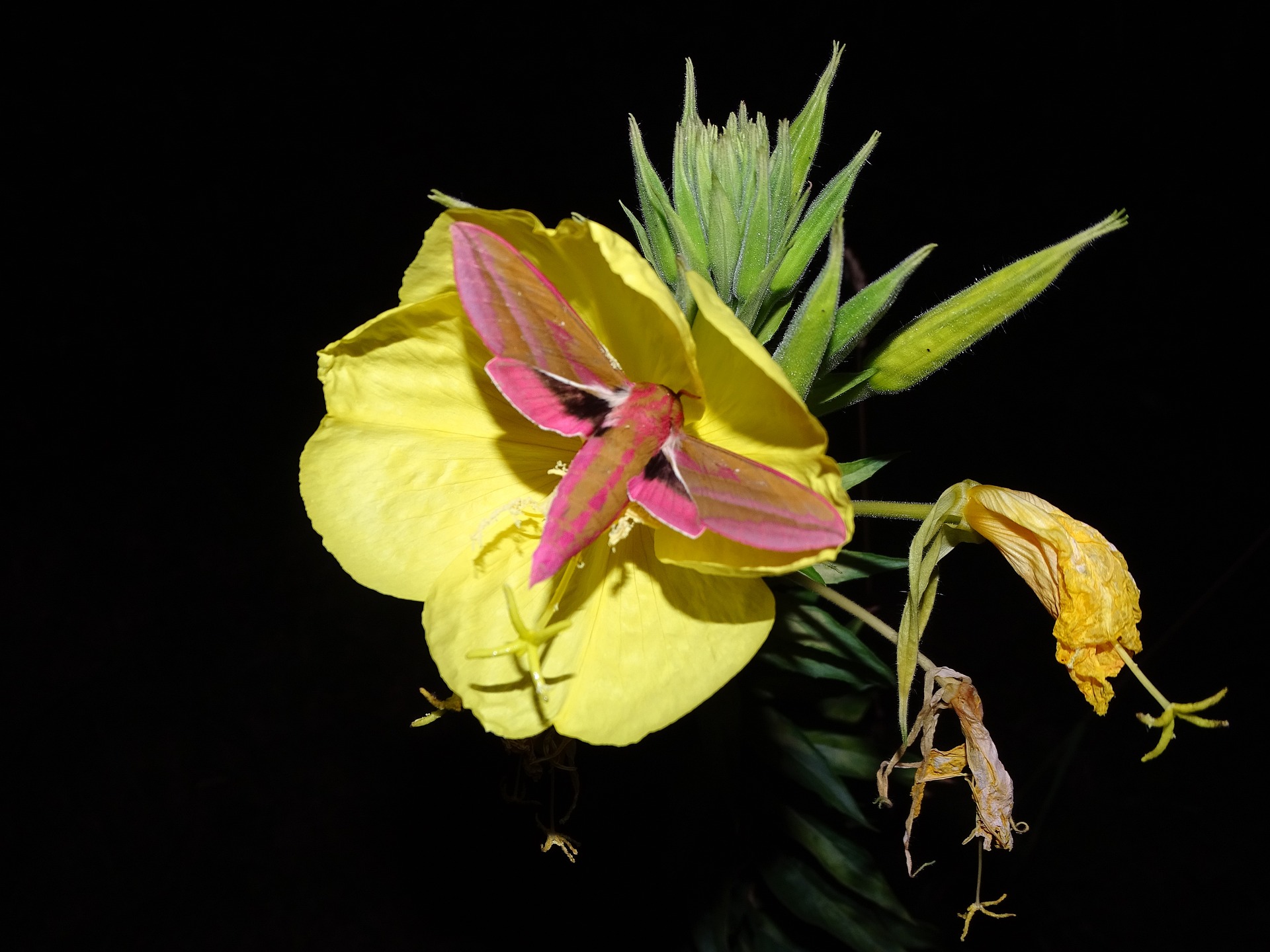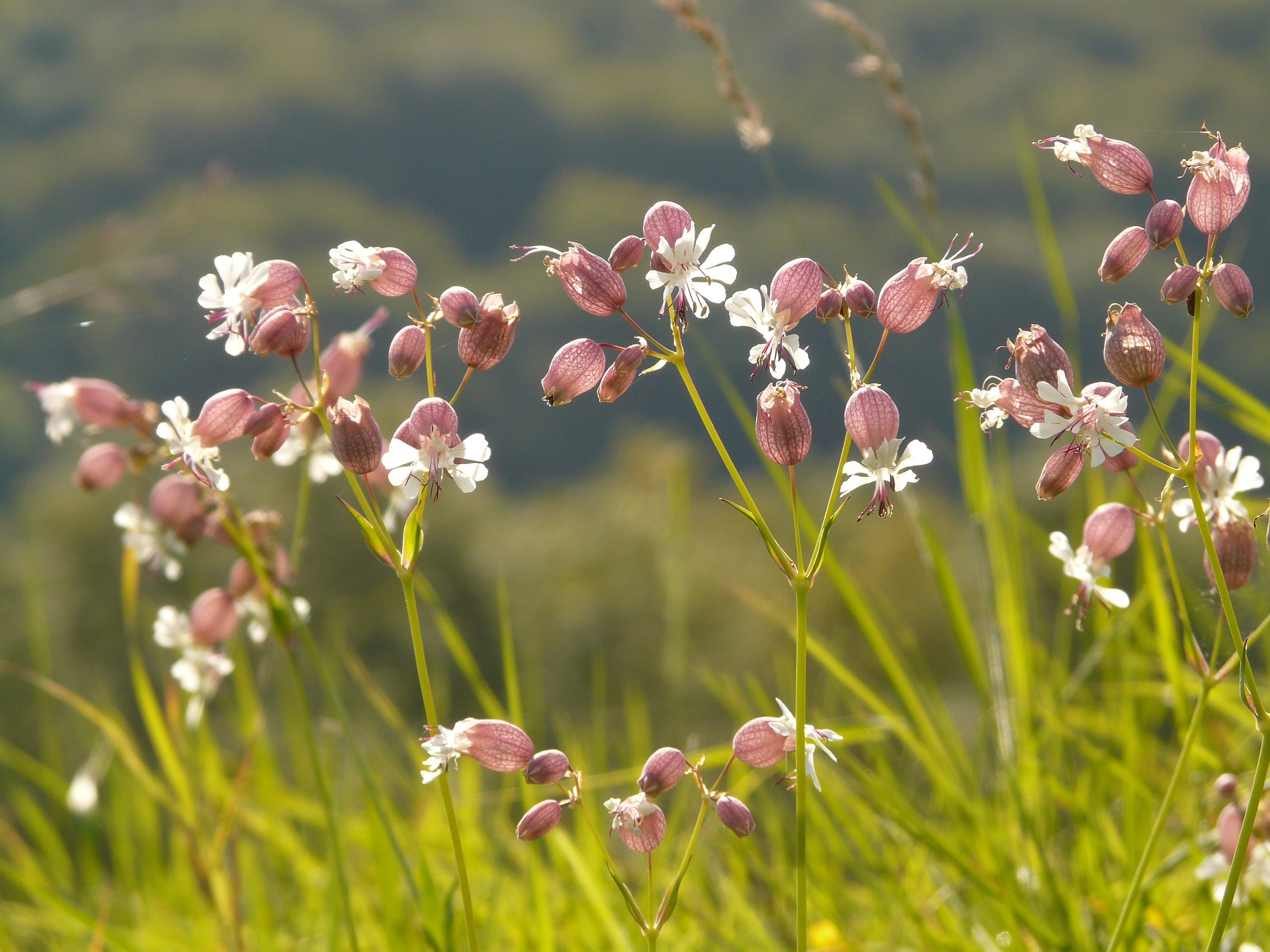Bright Side of the Night – 2.2.8
Plants
Plants carry out photosynthesis and generate energy with the help of sunlight. They need the dark night for regeneration processes. Plants also use light as an external timer. They respond to the cycles of day and night, the seasons, and the moon. Low light intensity initiates developmental processes in plants. High light intensity triggers stress and protective responses.
Moth Plants
Many plants that rely on nocturnal pollinators are characterized by their tantalizing fragrance and brilliant flower colours.[1] Observations show that moths tend to be attracted to bright flowers. The scent and flower colour help moths find their way. The colours white, yellow, pale purple, and all colours with a strong UV reflection are best seen. Night-flowering plants don’t just attract moths but also bats, which feed on the insects. The Fence Bindweed (Calystegia sepium), the Common Night Violet (Hesperis matronalis) and European Pipeviolet (Philadelphus coronarius) are examples of such moth plants.[2]
Common Evening Primrose
The common evening primrose (Oenothera biennis) is originally native to North America. It was brought to Europe as an ornamental plant and has spread widely. At dusk, its flowers open in a flowing motion over the course of just a few minutes. The suddenness and speed observed is unique in the flora of Central Europe. Once they bloom, moths like the medium vine hawk moth (Deilephila elpenor) can sense the intense scent. Immediately after the flowers have opened, the anthers ripen, so pollen sticks to the beaks of the visiting moths. About half an hour after the flower’s opening, the stigma branches unfold. Now, the flowers can be pollinated by other visiting insects. Primroses bloom all night long, until about midday the following day. The roots, leaves, flowers and seeds of the plant are edible. In natural medicine, the common evening primrose is used as a remedy for skin diseases, asthma, or migraine.
References
[1] Raguso, R. A., & Willis, M. A. (2005). Synergy between visual and olfactory cues in nectar feeding by wild hawkmoths, Manduca sexta. Animal Behaviour, 69(2), 407–418. https://doi.org/10.1016/j.anbehav.2004.04.015
[2] Brochure “Night in the Nature Parks of Luxembourg”

Further Resources
Links below will redirect you to external websites. In accordance with the European data protection declarations, we would like to point out that by clicking on these links you may send data to external providers. We cannot prevent that.
Images
Videos
![]() Science magazine: Robotic flowers show how moths see at night
Science magazine: Robotic flowers show how moths see at night
 Il cielo e l’inquinamento luminoso // Esperti in erbe, Natura&Colore 2023 – Ecomuseo Lis Aganis
Il cielo e l’inquinamento luminoso // Esperti in erbe, Natura&Colore 2023 – Ecomuseo Lis Aganis
Online Resources
![]()
 The influence of light pollution on plants, animals and ecosystems (Helle Not)
The influence of light pollution on plants, animals and ecosystems (Helle Not)
![]()
 What happens at night just beyond our doorstep? Bothersome-Brightness-Cartoons. (Helle Not)
What happens at night just beyond our doorstep? Bothersome-Brightness-Cartoons. (Helle Not)
![]()
 Verlust der Nacht / Loss of the Night: Interdisciplinary Research network
Verlust der Nacht / Loss of the Night: Interdisciplinary Research network
![]() Into the Night in the Kaunertal Valley (Online publication)
Into the Night in the Kaunertal Valley (Online publication)
![]() Lecture: Effect of light pollution on plants
Lecture: Effect of light pollution on plants
 Unterwegs in die Nacht im Kaunertal (Online publication)
Unterwegs in die Nacht im Kaunertal (Online publication)
 Konzept zur nachtbezogenen Naturpädagogik (Online publication)
Konzept zur nachtbezogenen Naturpädagogik (Online publication)
 Vuoi aiutare la fauna selvatica? Spegni la luce! – Focus
Vuoi aiutare la fauna selvatica? Spegni la luce! – Focus
 L’inquinamento luminoso colpisce anche l’uomo, oltre ad animali e piante – LifeGate
L’inquinamento luminoso colpisce anche l’uomo, oltre ad animali e piante – LifeGate
Further Readings
![]()
 Regularly updated Literature and links with regards to light pollution and dark skies (Helle Not)
Regularly updated Literature and links with regards to light pollution and dark skies (Helle Not)
![]()
 Literature & Links on the website “Verlust der Nacht/Loss of the Night”
Literature & Links on the website “Verlust der Nacht/Loss of the Night”
![]() Scientific Review Article on “Nocturnal pollination” (2020)
Scientific Review Article on “Nocturnal pollination” (2020)
Teaching Material
For Kids
![]()
 Materials for young scientists: Quiz, Arts and craft corner, App and Exhibition for schools. (Loss of the Night network)
Materials for young scientists: Quiz, Arts and craft corner, App and Exhibition for schools. (Loss of the Night network)
 Unterrichtsmaterialien für Schulen – “Tierprofi Wildtiere” (Die Umweltberatung)
Unterrichtsmaterialien für Schulen – “Tierprofi Wildtiere” (Die Umweltberatung)
 Unterrichtsmaterialien für Schulen – “Lichtverschmutzung” (Die Umweltberatung)
Unterrichtsmaterialien für Schulen – “Lichtverschmutzung” (Die Umweltberatung)
 Wissens- und Methodenbox „Kunstlicht, Nacht und Sternenhimmel“ (Naturfreunde)
Wissens- und Methodenbox „Kunstlicht, Nacht und Sternenhimmel“ (Naturfreunde)

